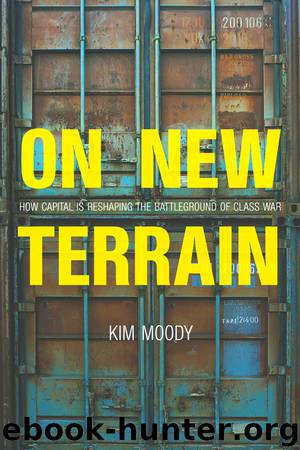On New Terrain by Kim Moody

Author:Kim Moody
Language: eng
Format: epub
Publisher: Haymarket Books
Published: 2017-11-09T05:00:00+00:00
Cities, Democrats, and Elections
Chapters 4 through 6 argue that a new terrain of class struggle has arisen based on the major changes in US capitalism in the last thirty years or so: the consolidation of capitalist enterprises, the increased capital intensity on the job, and the intense and vulnerable links provided by the rise of supply chain management and advanced logistics. These interrelated changes in the structure of capital are focused to a large extent on urban centers of so-called service work and the movement of goods, itself now a part of the process of production that serves regional and global manufacturing, and hence on concentrations of the reshaped urban working class of this era. While it will be easier to build a new organization or party in small cities like Richmond, California, or midsize ones like Seattle with nonpartisan electoral systems, the big cities are key to shifting power.
As bastions of the Democratic Party, they are also points of political vulnerability in that most of them are now virtually “one-party” Democratic city-states dependent on a mass working-class voter base that is, by almost any left analysis or recent polls, out of step with most of the mostly middle-class, heavily business-funded “representatives” holding most offices and positions in the party’s structure. Cities, as the electoral results of 2016 show, are also less susceptible to large-scale Trump support. Democratic politics vary from city to city, of course. New York, under Mayor Bill de Blasio, is allegedly a bastion of liberalism on the left of that spectrum, while Chicago under Emanuel epitomizes the worst of Democratic neoliberalism. Nevertheless, the overwhelming dominance of the Democrats in most of the larger cities also means there is less of a spoiler effect. Furthermore, this disconnect between the sentiments of the working-class voter base expresses itself in the incredibly low voter turnout that characterizes most municipal and state legislative elections. The turnout in New York mayoral elections, which has been falling for decades, was a mere 24 percent in 2013 when de Blasio was elected.31 As we will see in the discussion of the 2016 election below, non-voters are actually to the left of those who vote on a number of economic questions—and there are millions of them. A new party that can mobilize previous non-voters has a good chance of winning in the long run. This is a tinderbox awaiting a potential explosion if the disenchanted can be mobilized.
The high concentration of Democratic voters in most big cities means the Republicans are not strong enough to make a third-party challenge a spoiler in most local elections. The New York City Council, for example, has only three Republicans of out fifty-one council members, while the total Republican vote, disproportionately concentrated in those three Republican districts, accounted for only 16 percent of the 2013 council vote. Democrats carried the council elections by over 90 percent of the vote in twenty-one districts, by 80 percent in ten districts, and 70 percent in another five. In six districts the election of the Democrat was uncontested.
Download
This site does not store any files on its server. We only index and link to content provided by other sites. Please contact the content providers to delete copyright contents if any and email us, we'll remove relevant links or contents immediately.
| Anthropology | Archaeology |
| Philosophy | Politics & Government |
| Social Sciences | Sociology |
| Women's Studies |
The Secret History by Donna Tartt(18793)
The Social Justice Warrior Handbook by Lisa De Pasquale(12104)
Thirteen Reasons Why by Jay Asher(8761)
This Is How You Lose Her by Junot Diaz(6730)
Weapons of Math Destruction by Cathy O'Neil(6103)
Zero to One by Peter Thiel(5652)
Beartown by Fredrik Backman(5566)
The Myth of the Strong Leader by Archie Brown(5391)
The Fire Next Time by James Baldwin(5217)
How Democracies Die by Steven Levitsky & Daniel Ziblatt(5105)
Promise Me, Dad by Joe Biden(5055)
Stone's Rules by Roger Stone(5003)
A Higher Loyalty: Truth, Lies, and Leadership by James Comey(4817)
100 Deadly Skills by Clint Emerson(4816)
Rise and Kill First by Ronen Bergman(4670)
Secrecy World by Jake Bernstein(4611)
The David Icke Guide to the Global Conspiracy (and how to end it) by David Icke(4582)
The Farm by Tom Rob Smith(4412)
The Doomsday Machine by Daniel Ellsberg(4388)
